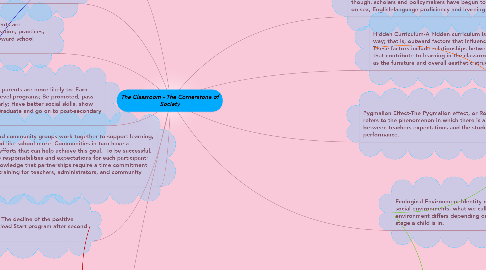The Classroom - The Cornerstone of Society
by Mona Dean

1. Heterogeneous Groups-Heterogeneous grouping is a type of distribution of students among various classrooms of a certain grade within a school. In this method, children of approximately the same age are placed in different classrooms in order to create a relatively even distribution of students of different abilities as well as different eduational and emotional needs. Gifted children will be scattered throughout the various grade level classrooms, rather than all together in one classroom.
2. Impact of legislation (i.e.; Brown v Board of Education & Lau v. Nichols)-Schools have been impacted by great lengths by legislation in the courts. We still are feeling the segregation effects from the Brown v. Board of Education lawsuit.
3. Diversity (Segregation and Integration)-Sometime segregation is simply the most practical way to address a problem or to target a solution (e.g., teaching a single language or meeting the needs of students with disabilities); on other occasions, segregation is an unintended result of a laudable effort, idea, or policy. Thus the dilemma is how to enhance students' cultural and linguist identity in schools while also encouraging and embracing equality.
4. Parent Involvement (lack of)-Students with involved parents are more likely to: Earn higher grades and test scores, and enroll in higher-level programs; Be promoted, pass their classes, and earn credits; Attend school regularly; Have better social skills, show improved behavior, and adapt well to school; and Graduate and go on to post-secondary education
5. Cultural Deficit-Poor and minority students are considered substandard in their socialization, practices, behaviors, language, and orientation toward school achievement
6. "Community Involvement (lack of)-When schools, families, and community groups work together to support learning, children tend to do better in school, stay in school longer, and like school more. Communities in turn have a responsibility to join with schools and families in support of efforts that can help achieve this goal. To be successful, school and community partnerships must: have clear, concise responsibilities and expectations for each participant; allow for flexibility in organization and implementation; acknowledge that partnerships require a time commitment and that initial gains may be small; and provide appropriate training for teachers, administrators, and community members.
7. Sleeper Effect- The decline of the positive impact of the Head Start program after second grade.
8. Hidden Curriculum-A hidden curriculum is one that is in the school in an indirect way; that is, outward factors that influence the students within the classroom. These factors include relationships between teachers and students, the activities that contribute to learning in the classroom, as well as other concrete factors such as the furniture and overall aesthetic structures inside the classroom itself
9. Pygmalion Effect-The Pygmalion effect, or Rosenthal effect, refers to the phenomenon in which there is a parallel between teachers expectations and the student’s performance.
10. Ecological Environment-Identity development occurs within physical and social environments, what we call the ecological environment. This environment differs depending on the specific identity development stage a child is in.
11. Achievement Gap-The “achievement gap” in education refers to the disparity in academic performance between groups of students. The achievement gap shows up in grades, standardized-test scores, course selection, dropout rates, and college-completion rates, among other success measures. It is most often used to describe the troubling performance gaps between African-American and Hispanic students, at the lower end of the performance scale, and their non-Hispanic white peers, and the similar academic disparity between students from low-income families and those who are better off. In the past decade, though, scholars and policymakers have begun to focus increasing attention on other achievement gaps, such as those based on sex, English-language proficiency and learning disabilities.


